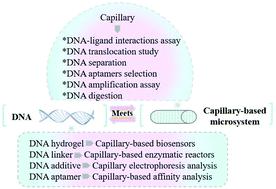Our official English website, www.x-mol.net, welcomes your feedback! (Note: you will need to create a separate account there.)
How does DNA ‘meet’ capillary-based microsystems?
Analyst ( IF 4.2 ) Pub Date : 2020-11-2 , DOI: 10.1039/d0an01336f Tingting Hong 1, 2, 3, 4 , Lin Qiu 1, 2, 3, 4, 5 , Shuwen Zhou 1, 2, 3, 4 , Zhiqiang Cai 1, 2, 3, 4, 6 , Pengfei Cui 1, 2, 3, 4 , Ronghui Zheng 1, 2, 3, 4 , Jianhao Wang 1, 2, 3, 4, 7 , Songwen Tan 4, 8, 9, 10 , Pengju Jiang 1, 2, 3, 4
Analyst ( IF 4.2 ) Pub Date : 2020-11-2 , DOI: 10.1039/d0an01336f Tingting Hong 1, 2, 3, 4 , Lin Qiu 1, 2, 3, 4, 5 , Shuwen Zhou 1, 2, 3, 4 , Zhiqiang Cai 1, 2, 3, 4, 6 , Pengfei Cui 1, 2, 3, 4 , Ronghui Zheng 1, 2, 3, 4 , Jianhao Wang 1, 2, 3, 4, 7 , Songwen Tan 4, 8, 9, 10 , Pengju Jiang 1, 2, 3, 4
Affiliation

|
DNA possesses various chemical and physical properties which make it important in biological analysis. The opportunity for DNA to ‘meet’ capillary-based microsystems is rapidly increasing owing to the expanding development of miniaturization. Novel capillary-based methods can provide favourable platforms for DNA–ligand interaction assay, DNA translocation study, DNA separation, DNA aptamer selection, DNA amplification assay, and DNA digestion. Meanwhile, DNA exhibits great potential in the fabrication of new capillary-based biosensors and enzymatic bioreactors. Moreover, DNA has received significant research interest in improving capillary electrophoresis (CE) performance. We focus on highlighting the advantages of combining DNA and capillary-based microsystems. The general trend presented in this review suggests that the ‘meeting’ has offered a stepping stone for the application of DNA and capillary-based microsystems in the field of analytical chemistry.
中文翻译:

DNA如何“满足”基于毛细管的微系统?
DNA具有各种化学和物理特性,因此在生物学分析中很重要。由于小型化的发展,DNA“满足”基于毛细管的微系统的机会正在迅速增加。基于毛细管的新方法可为DNA-配体相互作用测定,DNA易位研究,DNA分离,DNA适体选择,DNA扩增测定和DNA消化提供有利的平台。同时,DNA在制造新的基于毛细管的生物传感器和酶促生物反应器方面显示出巨大潜力。此外,DNA在改善毛细管电泳(CE)性能方面受到了广泛的研究兴趣。我们专注于突出结合DNA和基于毛细管的微系统的优势。
更新日期:2020-12-09
中文翻译:

DNA如何“满足”基于毛细管的微系统?
DNA具有各种化学和物理特性,因此在生物学分析中很重要。由于小型化的发展,DNA“满足”基于毛细管的微系统的机会正在迅速增加。基于毛细管的新方法可为DNA-配体相互作用测定,DNA易位研究,DNA分离,DNA适体选择,DNA扩增测定和DNA消化提供有利的平台。同时,DNA在制造新的基于毛细管的生物传感器和酶促生物反应器方面显示出巨大潜力。此外,DNA在改善毛细管电泳(CE)性能方面受到了广泛的研究兴趣。我们专注于突出结合DNA和基于毛细管的微系统的优势。



























 京公网安备 11010802027423号
京公网安备 11010802027423号